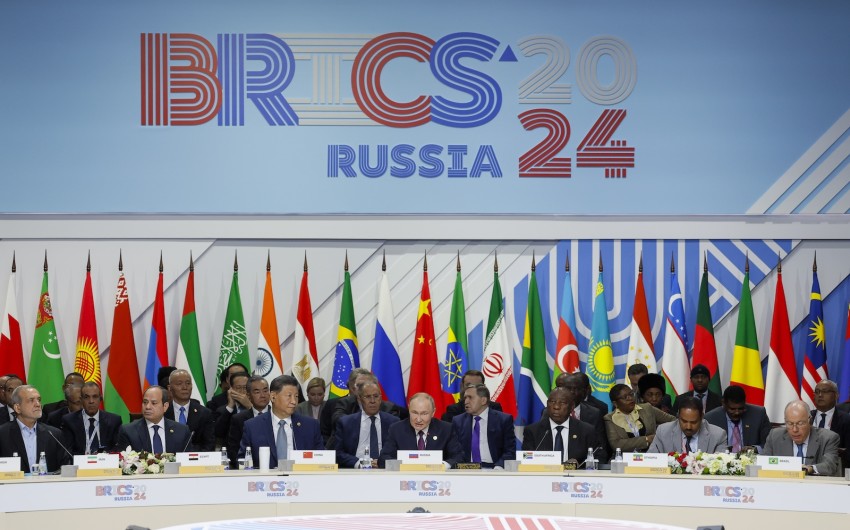The last two summits of BRICS countries have raised questions about the coalition’s identity and purpose. This began to come into focus at the summit hosted by South Africa in 2023, and more acutely at the recent 2024 summit in Kazan, Russia.
At both events the alliance undertook to expand its membership. In 2023, the first five BRICS members – Brazil, Russia, India, China and South Africa – invited Iran, Egypt, Ethiopia, Saudi Arabia and the United Arab Emirates to join. All bar Saudi Arabia have now done so. The 2024 summit pledged to admit 13 more, perhaps as associates or “partner countries”.
On paper, the nine-member BRICS+ strikes a powerful pose. It has a combined population of about 3.5 billion, or 45% of the world’s people. Combined, its economies are worth more than $28.5 trillion – about 28% of the global economy. With Iran, Saudi Arabia and the UAE as members, BRICS+ produces about 44% of the world’s crude oil.
Based on my research and policy advice to African foreign policy decision-makers, I would argue that there are three possible interpretations of the purpose of BRICS+.
- A club of self-interested members – a kind of global south cooperative. What I’d label as a self-help organization.
- A reforming bloc with a more ambitious goal of improving the workings of the current global order.
- A disrupter, preparing to replace the western-dominated liberal world order.
Analyzing the commitments that were made at the meeting in Russia, I would argue that BRICS+ sees itself more as a self-interested reformer. It represents the thinking among global south leaders about the nature of global order, and the possibilities of shaping a new order. This, as the world moves away from the financially dominant, yet declining Western order (in terms of moral influence) led by the U.S. The move is to a multipolar order in which the East plays a leading role.
However, the ability of BRICS+ to exploit such possibilities is constrained by its make-up and internal inconsistencies. These include a contested identity, incongruous values and lack of resources to convert political commitments into actionable plans.
Summit outcomes
The trend towards closer trade and financial cooperation and coordination stands out as a major achievement of the Kazan summit. Other achievements pertain to global governance and counter-terrorism.
When it comes to trade and finance, the final communiqué said the following had been agreed:
-- adoption of local currencies in trade and financial transactions. The Kazan Declaration notes the benefits of faster, low cost, more efficient, transparent, safe and inclusive cross-border payment instruments. The guiding principle would be minimal trade barriers and non-discriminatory access.
-- establishment of a cross-border payment system. The declaration encourages correspondent banking networks within BRICS, and enabling settlements in local currencies in line with the BRICS Cross-Border Payments Initiative. This is voluntary and nonbinding and is to be discussed further.
-- creation of an enhanced roles for the New Development Bank, such as promoting infrastructure and sustainable development.
-- a proposed BRICS Grain Exchange, to improve food security through enhanced trade in agricultural commodities.
All nine BRICS+ countries committed themselves to the principles of the U.N. Charter – peace and security, human rights, the rule of law, and development – primarily as a response to the western unilateral sanctions.
The summit emphasized that dialogue and diplomacy should prevail over conflict in, among other places, the Middle East, Sudan, Haiti and Afghanistan.
Faultlines and tensions
Despite the positive tone of the Kazan declaration, there are serious structural fault lines and tensions inherent in the architecture and behavior of BRICS+. These might limit its ambitions to be a meaningful change agent.
The members don’t even agree on the definition of BRICS+. President Cyril Ramaphosa of South Africa calls it a platform. Others talk of a group (Russia’s President Vladimir Putin, India’s Prime Minister Narendra Modi) or a family (Chinese foreign ministry spokesperson Lin Jianan).
So what could it be?
BRICS+ is state-driven – with civil society on the margins. It reminds one of the African Union, which pays lip service to citizens’ engagement in decision-making.
One possibility is that it will evolve into an intergovernmental organization with a constitution that sets up its agencies, functions and purposes. Examples include the World Health Organization, the African Development Bank and the U.N. General Assembly.
But it would need to cohere around shared values. What would they be?
Critics point out that BRICS+ consists of democracies (South Africa, Brazil, India), a theocracy (Iran), monarchies (UAE, Saudi Arabia) and authoritarian dictatorships (China, Russia). For South Africa this creates a domestic headache. At the Kazan summit, its president declared Russia a friend and ally. At home, its coalition partner in the government of national unity, the Democratic Alliance, declared Ukraine as a friend and ally.
There are also marked differences over issues such as the reform of the United Nations. For example, at the recent U.N. Summit of the Future the consensus was for reform of the U.N. security council. But will China and Russia, as permanent security council members, agree to more seats, with veto rights, on the council?
As for violent conflict, humanitarian crises, corruption and crime, there is little from the Kazan summit that suggests agreement around action.
Unity of purpose
What about shared interests? A number of BRICS+ members and the partner countries maintain close trade ties with the west, which regards Russia and Iran as enemies and China as a global threat.
Some, such as India and South Africa, use the foreign policy notions of strategic ambiguity or active non-alignment to mask the reality of trading with east, west, north and south.
The harsh truth of international relations is there are no permanent friends or enemies, only permanent interests. The BRICS+ alliance will most likely cohere as a global south co-operative, with an innovative self-help agenda, but be reluctant to overturn the current global order from which it desires to benefit more equitably.
Trade-offs and compromises might be necessary to ensure “unity of purpose”. It’s not clear that this loose alliance is close to being able to achieve that.
Anthoni van Nieuwkerk is Professor of International and Diplomacy Studies, Thabo Mbeki African School of Public and International Affairs, University of South Africa.
The Conversation is an independent and nonprofit source of news, analysis and commentary from academic experts.
- External Link
- https://theconversation.com/brics-could-shape-a-new-world-order-but-it-lacks-shared-values-and-a-unified-identity-242308
 Get your ticket to GaijinPot Expo 2024
Get your ticket to GaijinPot Expo 2024















7 Comments
Login to comment
TaiwanIsNotChina
It's an investment club. It's activities are limited to that.
TaiwanIsNotChina
Did they leave out "territorial integrity" at the request of russia?
TaiwanIsNotChina
The OECD is 1.4 billion people and 46% of world gdp. And unlike BRICSSI+, they have shared values.
kibousha
BRICS is more of a "keep members away from the west" arrangement than a "let's work together" arrangement, besides Russia and China, no one benefits from it.
dobre vam zajebava
lets see how this will work.
it may be good new alternative for many.
Zaphod
The three interpretations given in the article do not contradict each other. BRICS has elements of both. And its foundation is an alternative the American petrodollar scheme, which has dominated the globe for too long.
Pukey2
TaiwanChina:
Spoken like a scared mouse who's written three consecutive posts. You can't expect BRICS+ nations to always have the same values as it encompasses nations from all corners of the world, but one of the things it does share is a hatred of imperialism and colonialism. You can delude yourself all you like, but BRICS+ is the future. Have a look at the GDP growth of the G7 nations - about 1% growth, and each of their leaders either have low approval ratings or have already been booted out by their own people. Now compare this with BRICS+ and look at the GDP growth for Russia, India and China. China is already number one in terms of purchasing power parity.
Oh, and congratulations on your new president!